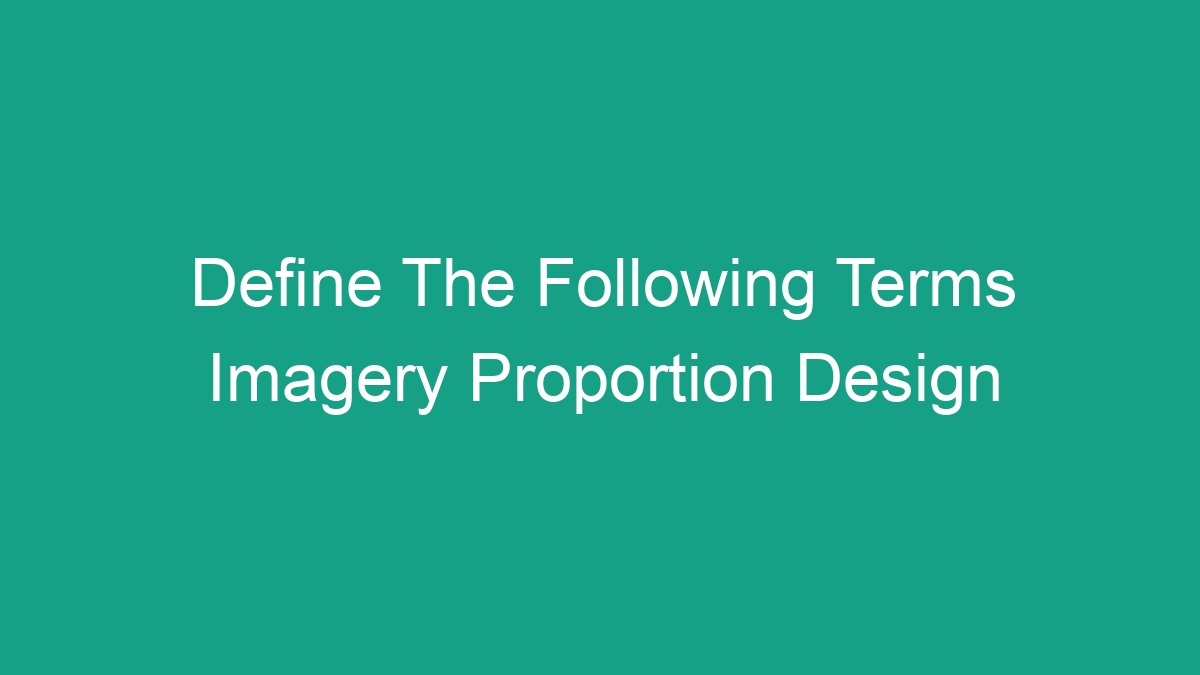
Introduction
Imagery, proportion, and design are fundamental concepts in various fields such as art, photography, architecture, and graphic design. Understanding these terms is crucial for creating visually appealing and effective visual content. In this article, we will define and discuss the importance of imagery, proportion, and design in different contexts.
Imagery
Imagery refers to the use of visually descriptive or figurative language or the use of visual elements to create mental images or evoke specific sensations. In other words, it is the use of visual elements to convey a message or evoke emotions.
Here are some key points to understand about imagery:
- Imagery can be found in various forms, such as photographs, paintings, drawings, and even in written text.
- It helps the audience to visualize and understand the message or story being conveyed.
- Imagery can be used to create a mood or atmosphere in a piece of visual content.
- It is used to engage the audience and create a memorable experience.
In photography, for example, imagery is used to capture and convey specific emotions, stories, or concepts through the composition, lighting, and subject matter of the photograph. In literature, writers use imagery to create vivid mental images for the readers, making the stories more immersive and engaging.
Proportion
Proportion refers to the relative size and scale of various elements in a design. It involves the relationship between different parts of an object or composition, as well as their relationship to the whole. Understanding proportion is crucial for creating balanced and visually pleasing designs.
Some important points about proportion include:
- Proportion is essential in creating a sense of harmony and balance in a design.
- It helps to guide the viewer’s eye and create a sense of order in the visual composition.
- Proper proportions contribute to the overall visual appeal and impact of a design.
- It plays a significant role in architecture, interior design, and graphic design, among other fields.
In architecture, proportion is critical in determining the overall appearance and feel of a building. A well-proportioned building is aesthetically pleasing and feels balanced. Similarly, in graphic design, understanding how different elements relate to one another in terms of size and scale is essential for creating compelling and effective designs.
Design
Design is the process of creating a plan or convention for the construction of an object, system, or measurable human interaction. It involves problem-solving and creating solutions through visual and structural organization.
Key points to understand about design are:
- Design encompasses various disciplines, including graphic design, industrial design, fashion design, and interior design, among others.
- It involves the intentional and strategic arrangement of elements to achieve a specific goal or purpose.
- Good design considers functionality, aesthetics, and user experience.
- Design thinking is a crucial skill in today’s competitive and visually-driven world.
In graphic design, for instance, designers use elements such as typography, color, and layout to create visually appealing and impactful communication materials. In industrial design, the focus is on creating functional and aesthetically pleasing products that enhance the user’s experience.
Importance of Understanding Imagery, Proportion, and Design
Understanding these concepts is vital for anyone involved in visual content creation, whether in art, photography, architecture, or design. Here are some reasons why imagery, proportion, and design are crucial:
- Effective Communication: Visual content is a powerful tool for communication, and understanding how to use imagery, proportion, and design can help convey messages more effectively.
- Enhanced Aesthetics: Good use of imagery and proportion can significantly improve the visual appeal of any artistic or design project, capturing the audience’s attention and leaving a lasting impression.
- User Engagement: In fields such as web design and marketing, understanding these concepts can lead to higher user engagement and better results.
- Professional Development: For individuals pursuing careers in the visual arts, a strong grasp of imagery, proportion, and design principles is essential for professional growth and success.
FAQs
What is the role of imagery in art and design?
Imagery plays a crucial role in art and design as it helps to convey messages, evoke emotions, and create visually appealing compositions. In art, imagery is used to express ideas and concepts, while in design, it is employed to communicate information and enhance the overall visual impact of a project.
How does proportion contribute to visual harmony?
Proportion ensures that the different elements in a design or composition relate to each other in a balanced and harmonious way. When elements are in proportion, they create a sense of visual order and coherence, leading to a more aesthetically pleasing and impactful result.
Why is design thinking important in problem-solving?
Design thinking encourages a creative and empathetic approach to problem-solving, focusing on human-centered solutions and innovation. It helps in identifying and addressing the needs of users, ultimately leading to more effective and user-friendly outcomes.
In conclusion, imagery, proportion, and design are critical components of visual content creation, with implications across various fields. Through understanding these concepts, individuals can effectively communicate, create visually appealing compositions, and solve problems through thoughtful and intentional design.


